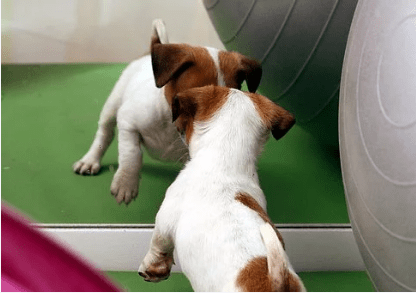Dr. Gordon Gallup Jr. invented the mirror test, officially called the self-identification mirror test, or MSR test in 1970. Gallup, a biologist, devised the MSR test to assess animal self-awareness, to see if animals Visually capable of identifying themselves in front of a mirror.
Gallup believes that if animals identify themselves in the mirror, they can be considered capable of meditation.
The mirror test to measure animal perception works as follows: First, the animals being tested are placed under anesthesia so that their body can be distinguished in some way, and a mark on the animal’s body can be anything from a sticker to a colored face.
After the animals wake up from the anesthesia, they are given a mirror, and if the animals touch the mark or examine it in any way on their body, they pass the test. According to Gallup, this means that animals understand that the reflected image is their own, and they recognize themselves. Gallup assumed that animals who failed the self-identification test. thought the picture was of another animal.
The MSR test did not pass without its critics, and the initial criticism of the test is that it may produce false negatives, because many animal species are not optically oriented and many have biological limitations around the eyes such as dogs that are unlikely to use only hearing and olfactory sensitivity to navigate the world. But they also see direct eye contact as aggression.
Gorillas, for example, also hate contact with the eyes and will not spend enough time searching the mirror to identify themselves, which has been put forward as a reason for the failure of many (but not all) animals to the mirror;s test. In addition, gorillas are known to react sensitively to Somehow when they feel they are being observed, which may be another reason for the failure of the MSR test.
Another criticism of the MSR test is that some animals respond very quickly, as a natural instinct to their reflection. Because if smart animals like these primates take longer to look (or give more time to think) about the meaning of reflection, they may pass the test.
In addition, it is noted that some animals (and perhaps even humans) may not find the mark unusual enough to investigate or respond to, but that does not mean that they do not have self-awareness. An example of this is a specific example of a test. Rhesus monkeys, although they do not naturally tend to pass the mirror test, they have been trained by humans to do so and have been able to pass it.When they appear in the mirror, they react differently and appear to be very interested in their reflections.
MSR may not be the most accurate test and may have faced a lot of criticism, but it was an important hypothesis at the time of its creation and may lead to better tests of self-awareness and general perception of different animal species.
As of 2017, it has been observed that only the following animals have passed the MSR test:
Big monkeys: bonobos, chimpanzees, orangutans, and gorillas.
Some Asian elephants, glass-nosed dolphins, which are keen to check marks, often make movements such as removing tongues or wrapping their heads in front of a mirror.
In addition to Orca whales, which scientists believe expect a difference in their image after being distinguished, indicating a high level of self-recognition. Some types of birds such as pigeons, kia and magpie. Red ants, which seem to try to remove markings when they see themselves in the mirror and react differently when other ants appear through the glass.
